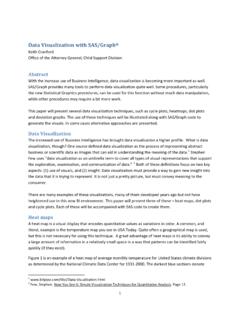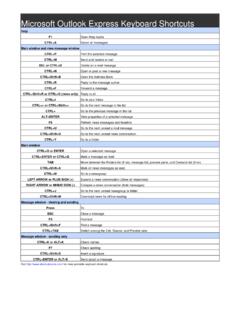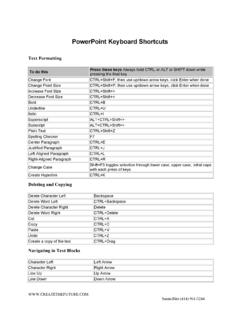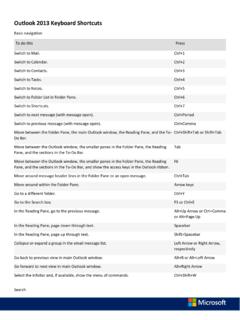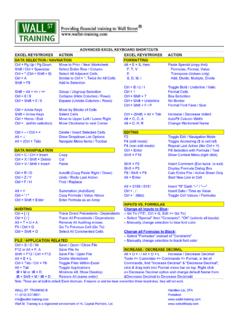Transcription of Shortcuts to Save Time While Working with SAS® - scsug.org
1 1 Shortcuts to Save Time While Working with SAS Ruth Marisol Rivera Barragan, PPD ABSTRACT Have you asked to yourself things like these? Can I clear the log and output windows with a shortcut ? How can I review the log faster in an interactive session? Is there a button that can do it for me? If you answered "Yes" to at least one of these questions, continue This paper will give you a list of Shortcuts that will make your experience Working with SAS faster, for example: How to make your log and output windows clear before you run your program, just by hitting an F key.
2 How to customize buttons to check your log interactively. How to find a specific value on a dataset, without to scroll down for all the variables available, just by using the correct operator in the where expression. And some other interesting topics that really will help you to save time! INTRODUCTION Very often, we are in stressful situations that does not allow us to waste time, we need to act as fast as possible, this paper will give you some tools that make your programming life easier, especially when you are in a hurry.
3 It is important to mention that these tools will work only when you are running programs in an interactive SAS session. Let me show you some examples that we will cover on this paper: Have you had to re run a code because you did not clear the LOG before? o You can clean it hitting an F key. How can you make sure your LOG is clean? o This paper will show you how to do it with a simple click Which is the way you use to look for all the possible values that a specific VARIABLE has? o You can do it quicker if you use the WHERE IN expression.
4 Have you used the COMMAND BAR? o It is very helpful and simple to use. 2 CUSTOMIZING YOUR KEYBOARD You can select the commands that you want SAS performs when you hit and F key, or any simple combination of keys (like Ctrl+L). If you hit F9 key when you are in your SAS session, you will see a window similar to this: 1. Go to the F3 line and edit it, to say: log; clear; output; clear; wpgm; submit; 2. Then go to the File menu, and select, Save . 3. Close the KEYS <DMKEYS window. Now go to your program and hit F3 , what do you think it will happen?
5 You got it! This simple action, will go to the LOG window and clean it, then will go to the OUTPUT window and clean it, and finally will go to the EDITOR window and submit your program. So simple right? Let s go to the next tool. 3 CUSTOMIZE BUTTONS To make your LOG review easier, you can customize the Application Tool Bar (by adding buttons). 1. Once you are in your LOG window, just go to the Tools menu, then select Customize 2. In the next window, select the Customize tab and select the Add Tool button: 4 3.
6 Then you will see the Command, Help text and Tip text clean to type the command you want to execute when your new button is added. 4. Let s type the command FIND ERROR , and just put the Help text and Tip text you want to see when the mouse is over you new button. 5 5. Then go to the Change icon button, to select the icon you want your new button has. Once you have selected your desired icon, hit ok in the Bitmap Browser window. 6 6. You will see your new button-command created and if you want, you can select the position you want it has in the Application Tool Bar, (by using the arows).
7 Once you are done with the customization of your buttons, hit the Save button. 7. ,Finally, check the Save tools for Log option in the new window will appear, then hit ok. 7 8. Now, when you get back to your log window, you will see the new button is added to the Application Tool Bar. 9. You will realize that when you give a click on your button, the pointer will move automatically to the line where the word ERROR is. NOTE: You can use this method to look any prohibited LOG words that you want (like WARNING, Uninitialized, etc.)
8 Just make sure you use the capitalization correctly and also use quotation marks ( ), otherwise the command will not be Working fine. Are you ready for the next tip? 8 LOOK FOR A LIST OF VALUES USING A WHERE-IN EXPRESSION Typically when Working with big datasets, we do not know all the possible values that a variable may contain. It could be just a couple or thousands! What about the number of variables is also big? That makes complicated to deal with the do you agree? Let s see a basic example: At the first look, we are not very sure which are all the possible values for each variable on the dataset 1.
9 Right click in the dataset and select Where condition. 9 2. Select the variable you want to research. 3. The tricky part comes which operator do you usually select? EQ? If you response was yes, I think you selected the long way , if you select that operator and want to see the list of values for the variable, you will need to scroll down until the LOOKUP distinct values option will appear. You will need to do it as many times as needed (let s imagine you have 100 variables at least), did you realize how many times do you have to scroll down until you find that option?
10 Let s try a shorter way .. 4. Instead of select EQ , select the OTHER Operators option 10 5. Then select IN 6. This action, will give you directly to the LOOKUP distinct values option that we wanted to see! 7. Finally, you will be able to see the list of values that the selected variable has. Ready for the last tip? 11 USING THE COMMAND BAR This is a simple tool that you can use to filter the dataset, when you already know the value you want to see 1. Just type the where expression it in the command bar.




